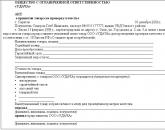Cost: calculation formula and concept of the term
Cost: what is it?
Calculating the cost of manufactured goods is a very difficult task that requires certain knowledge and skills. In companies, this indicator is calculated by, which calculates future income, taking into account all existing production costs.
What is included in the concept of cost and what is the formula for calculating this indicator, let's try to figure it out below.
The cost of production is the total cost of the enterprise for the production of a particular product, expressed in monetary terms.
The cost price is an economic category that reflects the amount of funds spent by the enterprise on, aimed at the production of products. The size of the net company directly depends on the value of the cost price, the lower this indicator, the more efficiently the company works.
Cost types
The cost is divided into full and marginal.
Full (average) is the total of all company expenses for manufacturing, this also includes the costs of manufacturing products, as well as the cost of commercial equipment.
How is the cost of production formed?
The most common method of calculating the cost is costing. Using this simple method, you can easily calculate the cost per unit of output. The most effective way to calculate this value is by the comparable controlled price method, which is fixed on the basis of the cost of services provided by competitors.
Costing is the calculation of the total costs in monetary terms for the manufacture of a unit or batch of units of products. Calculation allows you to calculate both the actual and planned cost of a particular object and is the basis for determining their price for sale in retail outlets.
Spending classification
As they influence the manufacturing process, all expenses are usually divided into:
- direct - these are the costs of raw materials and materials used in the manufacturing process of products, personnel involved in the manufacturing process;
- indirect - these are overhead costs that do not directly affect production activities, but are related to the object of calculation by the distribution method in the manner adopted by the enterprise.
Indirect costs are divided into:
- general production,
- general business,
- commercial.
In relation to the quantity of output, expenses are divided into:
- constant - not dependent on the quantity of products, which are indicated per unit of goods and tend to change along with fluctuations in business activity;
- variables - change with the amount of output produced.
Depending on the business qualities of management, the costs are:
- relevant, i.e. dependent on management decisions
- irrelevant - expenses that are not affected by the activity and actions of management
There are several different ways to calculate the cost of a product released for . Each economist, depending on the type of work and technological features, chooses a method that is suitable for him.
Cost formula
At the moment, the following calculation methods are used:
- normative,
- by process,
- across,
- ostentatious.
The first counting technique is used in those who are engaged in mass serial production of products. The purpose of this accounting method is to timely identify and prevent the inefficient use of various kinds of resources. At its core, this method contains economically justified average expenditures required for the operation of resources per unit of manufactured products. The norms established by calculation indicate the effectiveness of the management and organization of the company's work and affect its profitability and further development.
The normative method of counting is carried out in the following sequence:
- the estimated value of the standard price for each type of goods is calculated;
- amplitude norms are determined over a certain period for fluctuations in the calculated cost value;
- all costs are calculated within one period in relation to the rates of their change;
- the causes of fluctuations in indicators are determined;
- the result of the total cost is determined, which consists of the standard value, fluctuations in the norms and their deviations.
The main condition for using this method is the constant determination of deviations from the planned norms at the end of each period.
The value of deviations reflects the observance of technologies in production, compliance with the norms for the use of material resources, as well as the efficient use of working time. Such deviations are divided into positive (cost savings) and negative (additional costs).
The formula for the standard cost accounting method (actual) looks like this:
Fs = Hs ± On ± In,
where Нс is the standard cost;
In - change in the standard;
He is an aberration.

The process-by-process method is used in large companies where products are manufactured in large batches in short periods of time, when there are no leftovers or defects. The calculation is made on the basis of the summation of all cost items used to release the entire batch of goods.
The unit cost is calculated by dividing the total cost per consignment by the quantity of finished goods. To make it easier to control spending, the entire manufacturing process is divided into stages or processes.
The progressive method is used to account for the cost of production in which the costs of redistribution are calculated. These are all types of processing of materials or raw materials, regardless of its specifics.
The ostentatious method is used in calculating the cost by summing up the direct costs in the context of the individual for the manufacture of products of different types. The cost of a unit of a certain product is calculated by calculating the quotient from the total of expenses and the number of units of goods in a certain contract.
The total cost of manufactured products is calculated taking into account the following expenses:
Material costs (MR):
- raw materials and supplies,
- energy consumption,
- general production expenses.
Salary (FROM):
- salaries of workers in production,
- maintenance staff salaries,
- employees,
- administration fees,
- social payments (SP).
- depreciation (A),
- other (D).
Thus, the basic formula for accounting for the full cost price is as follows:
PS \u003d MP + OT + SP + A + D.
The cost of goods sold reflects its price based on the calculation of expenses for its manufacture. Therefore, you first need to calculate the costs, which vary depending on the manufacturing process. That is, they calculate the amount of variable costs per unit of goods produced. Then the amount of additional costs is added to the resulting value.
The formula for calculating the cost of goods sold is as follows:
Sbrp \u003d SB pr + UPT,
where Cbsp is the cost of goods sold, SB pr is the cost of goods sold, based on variable costs, and Rf is conditional fixed costs.
One of the most important elements of planning is the calculation of the planned cost, which is carried out to determine the amount of expenses for the future. Such a calculation is carried out mainly at the beginning of the calendar year, and the results obtained are painted quarterly.
To calculate the planned cost price, the following data is needed:
- production plan,
- direct costs incurred by the company to prepare for work,
- consumption rates of material resources,
- energy consumption rates,
- price.

The cost price combines a number of costs for the manufacture of products
The formula for calculating the planned cost itself has the same form as for calculating the actual cost, but instead of the indicator of actual costs, it is necessary to substitute the planned costs.
The calculation of the cost of manufactured or sold products is necessary for the most accurate planning of the enterprise and obtaining the expected results from such activities.
At various enterprises and stages of production, different types of cost are calculated, but the essence of this indicator is absolutely identical, because it reflects the amount of expenses incurred.
The cost indicator needs to be known not only for effective planning, but also for analyzing the effectiveness of the costs incurred and the work as a whole. By analyzing the cost of production, companies can take steps to reduce it in order to generate greater profits.
Noticed an error? Select it and click Ctrl+Enter to let us know.
Write your question in the form below
Popular
- How to get a TIN: possible ways
- What kind of business can you do?
- Written notice of termination of the lease
- Business from scratch. Things to do?
- Cost of goods sold: formula, methodology and calculation example
- How to write a vacation application - examples
- What kind of business can be opened in a small town or village?
- The formula for calculating the cost of services, products sold and total cost
- Sample memorandum: I bring to your attention
- Example of an explanatory note for being late for work




